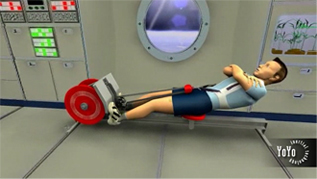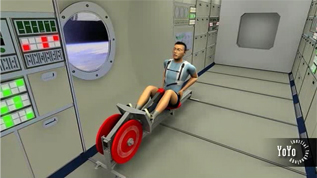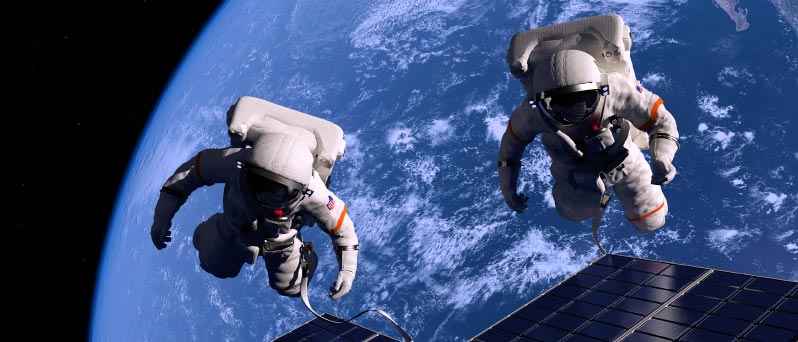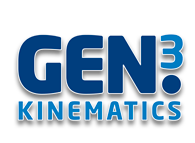NASA astronauts who habituated on Skylab – a space station orbiting the Earth from 1973 to 1979 – experienced muscle loss. Resistance exercise is clearly the best method to build muscle, yet very challenging in space. The problem to “lift weights” in space to combat muscle atrophy, was eventually solved through pioneer research by YoYo Technology© and nHANCE™ inventors Drs. Berg and Tesch of the Karolinska Institute in Stockholm, Sweden.

Astronauts in Skylab were the first to experience and report muscle loss and weakness after spending months in space. This is because the human body relies on gravity to maintain muscle mass, strength and power.
Without normal gravitational pull, skeletal muscle and bone mass decrease, much as when patients are confined to bed. While resistance by far is the best method to build muscle, the technical and physiological challenges of combating muscle atrophy by “lifting weights” in weightlessness are obvious.
Through the pioneer research by Drs. Hans Berg and Per Tesch of the Karolinska Institute, Stockholm, Sweden, describing the efficacy of flywheel inertial technology, astronauts now have access to the ultimate in-flight exercise tool.
Because this technology does not rely on gravity, hydraulics, or any external power source, technically it constitutes the perfect choice for resistance exercise in space.
Equally important, the nHANCE™ MultiGym designed for the International Space Station (ISS) emphasizes exercises that offers loading, and if desired maximal stress, of muscles and bones of the lower body.
Thus, it is critical calf, quadriceps, gluteal and lower back muscles are heavily involved, and that the tibial, femoral and pelvic bones, and the vertebral column are under significant mechanical stress.
The nHANCE™ MultiGym configuration allows for more than ten back, trunk and upper and lower limb exercises to comply with NASA requirements of a compact space resistive exercise device.


RESEARCH IN SPACE
A research project performed with the Russian space agency, “want to be astronauts” were locked up and confined in a space station mock up for 120 days, with no interaction with the surrounding world. One mission was to operate, test and carry out exercise using the nHANCE™ MultiGym several days a week. After returning to the “the real world”, the volunteers showed markedly improved muscle performance, and reported no operation malfunction and minimal need for maintenance despite daily, heavy machine use over 4 months.
Space experiments have used “weightlessness simulation” models at 1-g to study how nHANCE™ exercise can combat muscle and bone loss.
Both unilateral lower limb suspension and bed rest produce ~10% atrophy of calf and quadriceps muscles over five weeks. Supine Squat nHANCE™ resistance exercise, four sets of seven reps every third day, effectively blunts quadriceps muscle atrophy in men subjected to bed rest for 90 days.
Men and women, subjected to unilateral lower limb suspension for five weeks while performing nHANCE™ knee extensions, even showed hypertrophy. Marked bone loss, seen after 90 days bed rest, is reduced by “supine calf raises” using nHANCE™. Other campaigns have tested use of the nHANCE™ MultiGym in extreme environments, e.g., the Concordia Antarctis expedition, and parabolic flight producing repeat zero-g exposure.
THE A-FIT PROJECT: HEALTH AND FITNESS ON EARTH FOR ASTRONAUTS

The European Space Agency (ESA) has awarded the Karolinska Institute contract to coordinate the A-fit (Astronaut exercise prescriptions promoting health and fitness on earth) research program.
Headed by Dr. Per Tesch, the multi-national A-fit team, involving six academic partners or affiliations will conduct joint, or complementary research towards a common goal. Serving as industrial partner is YoYo Technology AB (Inc), from 2014 and on offering its established products under the brand name nHANCE™.
Muscle disuse, as a result of aging, inactivity or disease is a significant health issue in the civilized world. Research results have clearly shown that resistance exercise can offset or blunt many associated negative effects of disuse on muscle, bone and other vital, organ systems. Space, or more specifically microgravity, offers a unique environment as a research laboratory, and allows for both mechanistic and time-course studies of skeletal muscle in healthy individuals. Similar to muscle disuse on earth, chronic exposure to the microgravity environment provokes skeletal muscle atrophy, and metabolic and neuromuscular dysfunction.
Ultimately, the overall goal of the A-fit project is to explore the effects of in-flight exercise regimens, using a non-gravity dependent device, during long-duration missions on the International Space Station (ISS).
Prior to these experiments, a series of ground-based studies validate the efficacy and feasibility of unique exercise technology in healthy, injured, diseased or old populations. Collectively, the outcome of these efforts, and the research conducted within the frame work of A-fit, will be important in deciding on the final design of exercise hardware, and equally important, exercise prescriptions, for space travelers.
These results will also aid in understanding how disused skeletal muscle, and other tissues and organ systems, respond to chronic resistance exercise and further, how skeletal muscle adapts to concurrent aerobic and resistance exercise.
Finally, the A-fit research program will produce results that advance terrestrial applications using novel exercise technology.













